Maeve O'Meara journeys into the beguiling, gently spiced world of Moroccan food and meets a range of top chefs and home cooks who are passionate about their delicious cuisine. Maeve joins her friend restaurateur Omar Majdi who gives tips on the top spices and ingredients needed for Moroccan food and makes a dressing for fruit salad using sugar syrup, orange-blossom water, cinnamon and lemon juice that he predicts will be the hit of summer.
Homecook Malika Ennaim shows how easy it is to make your own harissa and preserved lemons, we learn from Saana Zaki how most of us are missing out on the fluffy marvellousness of couscous and some tips to make the instant variety taste amazing. Chef Hassan M'souli, the "Tajine King", explains why the tajine—a conical terracotta cooking pot—makes food taste especially good, and demonstrates with one of the favorite dishes of Morocco: chicken with green olives and preserved lemons.
Chef Aziz Bakhalla marinates lamb for the barbeque with a handful of spices and whips up a dip using fava beans. Student Sarah Ennaim shows how easy and delicious a Moroccan carrot salad is to make, and shares the recipe that all her friends keep clamouring for. And finally, Rashid Benz shows the elegant way of serving Moroccan mint tea (a green tea with mint leaves) and gives tips on the easiest way to make it.
Click here for the recipes featured in this episode.
About Morocco:
- Menu
Morocco, officially the Kingdom of Morocco, is a country located in North Africa. It primarily administers the disputed region of the Western Sahara. It is part of the Maghreb region, in addition to Tunisia, Algeria, Mauritania, and Libya, with which it shares cultural, historical and linguistic ties. The capital is Rabat, and the largest city is Casablanca; other large cities include Marrakesh, Tetouan, Tangier, Salé, Fes, Agadir, Meknesand Oujda.
Morocco is a country of multi-ethnic groups with a rich culture and civilization. Throughout Moroccan history, Morocco has hosted many people in addition to the indigenous Berbers, coming from both (Phoenicians, Carthaginians, Jews and Arabs), South (Sub-Saharan Africans) and North (Romans, Vandals, Andalusians (including Moors and Jews). All of which have had an impact on the social structure of Morocco. It conceived many forms of beliefs, from paganism, Judaism, Christianity to Islam.
Each region possesses its own uniqueness, contributing to the national culture. Morocco has set among its top priorities the protection of its diversity and the preservation of its cultural heritage.
Ancient Morocco:
The Capsian culture brought Morocco into the Neolithic about 2001 BCE, at a time when the Maghreb was less arid than it is today. The Berber language probably was formed at roughly the same time as agriculture. Modern DNA analysis has confirmed that various populations have contributed to the present-day gene pool of Morocco in addition to the main ethnic group which is the Amazighs/Berbers. A very small percentage of those other populations are Iberians and sub-Saharan Africans.
Phoenician traders, who had penetrated the western Mediterranean before the 12th century BCE, set up depots for salt and ore along the coast and up the rivers of the territory that is now Morocco. The arrival of Phoenicians heralded many centuries of rule by foreign powers for the north of Morocco. Major early substantial settlements of the Phoenicians were at Chellah, Lixus and Mogador, with Mogador being a Phoenician colony as early as the early 6th century BCE.
Carthage developed commercial relations with the Berber tribes of the interior and paid them an annual tribute to ensure their cooperation in the exploitation of raw materials. By the 5th century BC, Carthage had extended its hegemony across much of North Africa. By the 2nd century BCE, several large, although loosely administered, Berber kingdoms had emerged.
After the fall of Carthage, the area was annexed to the Roman Empire in 40 CE. Rome controlled the vast, ill-defined territory through alliances with the tribes rather than through military occupation, expanding its authority only to those areas that were economically useful or that could be defended without additional manpower. Hence, Roman administration never extended outside the restricted area of the northern coastal plain and valleys. The region remained a part of the Roman Empire until 429 CE as the Vandals overran the area and Roman administrative presence came to an end.
In the 5th century, as the Roman Empire declined, the region fell to the Vandals, Visigoths, and then the Byzantine Empire, the Eastern Roman Empire, in rapid succession. During this time, however, the high mountains of most of modern Morocco remained unsubdued, and stayed in the hands of their Berber inhabitants.
Christianity was introduced in the 2nd century and gained converts in the towns and among slaves and Berber farmers. By the end of the 4th century, the Romanized areas had been Christianized, and inroads had been made as well among the Berber tribes, who sometimes converted en masse. But schismatic and heretical movements also developed, usually as forms of political protest. The area had a substantial Jewish population as well. It was during this time that Morocco became a Jewish kingdom until the arrival of Islam.
Back to Menu  |
Medieval Ages & Early Modern Era:
Islamic expansion began in the 7th century. In 670 CE, the first Islamic conquest of the North African coastal plain took place under Uqba ibn Nafi, a general serving under the Umayyads of Damascus. Arabs brought their language and Islam, to which most of the Berbers converted.
After the outbreak of the Great Berber Revolt in 739 CE, the region's Berber population asserted its independence, forming states and kingdoms such as the Miknasa of Sijilmasa and the Barghawata. Under Idris ibn Abdallah, who was appointed by the Awraba Berbers of Volubilis to be their representative, the country soon cut ties and broke away from the control of the distant Abbasid caliphs in Baghdad and the Umayyad rule in Al-Andalus. The Idrisids established Fes as their capital and Morocco became a centre of Jewish learning and a major regional power.
Morocco would reach its height under a series of Berber dynasties that replaced the Idrisids after the 11th century. From the 13th century onwards the country has seen a massive migration of Banu Hilal Arab tribes. Their arrival was to have a critical effect on the nation: due to them nomadism returned, urban civilization fell and the country's inhabitants were quickly becoming Arabized. The Maghrawa, the Almoravids, the Almohads, the Marinids, the Wattasids and finally the Saadi dynasty would see Morocco rule most of Northwest Africa, as well as large sections of Islamic Iberia, or Al-Andalus. Following the Reconquista of the Iberian Peninsula, large numbers of Muslims and Jews were forced to flee to Morocco.
After the Saadi, the Alaouite Dynasty eventually gained control, who have since been the ruling house of Morocco. Morocco was facing aggression from Spain and the Ottoman Empire that was sweeping westward. The Alaouites succeeded in stabilizing their position, and while the kingdom was smaller than previous ones in the region, it remained quite wealthy. The organization of the kingdom developed under Ismail Ibn Sharif (1672–1727), who, against the opposition of local tribes began to create a unified state. With his Black Guard he drove the English from Tangier (1684) and the Spanish from Larache (1689).
Morocco was the first nation to recognize the fledgling United States as an independent nation in 1787. In the beginning of the American Revolution, American merchant ships were subject to attack by the Barbary Pirates while sailing the Atlantic Ocean. On December 20, 1777, Morocco's Sultan Mohammed III declared that the American merchant ships would be under the protection of the sultanate and could thus enjoy safe passage. The Moroccan-American Treaty of Friendship stands as the U.S.'s oldest non-broken friendship treaty.
Back to Menu  |
Modern Morocco:
Despite the weakness of its authority, the Alaouite dynasty distinguished itself in the 18th and 19th centuries by maintaining Morocco's independence while other states in the region succumbed to the Ottoman Empire, French, or British domination. However, in the latter part of the 19th century Morocco's weakness and instability invited European intervention to protect threatened investments and to demand economic concessions.
The first years of the 20th century witnessed a rush of diplomatic maneuvering through which the European powers and France in particular furthered their interests in North Africa. Disputes over Moroccan sovereignty were links in the chain of events that led to World War I.
Under French and Spanish Rule:
In 1912, after the First Moroccan Crisis and the Agadir Crisis, the Treaty of Fez was signed, effectively dividing Morocco into a French Morocco and Spanish Morocco as their protectorates. Many Moroccan soldiers (Goumieres) served in the French army in both World War I and World War II, and in the Spanish Nationalist Army in the Spanish Civil War and after (Regulares).
Under the French protectorate, Moroccan natives were denied their basic human rights such as freedom of speech, the right of gathering and travel in their own country. French settlers built for themselves modern European-like cities called "villages" or "villes" next to poor old Arab cities called "Medinas". The French apartheid system forbade native Moroccans from living, working, and traveling into the French quarters.
The rise of a young Moroccan intellectual class gave birth to nationalist movements whose main goals were to restore the governance of the country to its own people. Nationalist political parties, which subsequently arose under the French protectorate, based their arguments for Moroccan independence on such World War II declarations as the Atlantic Charter (a joint U.S.-British statement that set forth, among other things, the right of all people to choose the form of government under which they live). A manifesto of the Istiqlal Party (Independence party in English) in 1944 was one of the earliest public demands for independence. That party subsequently provided most of the leadership for the nationalist movement.
Independence:
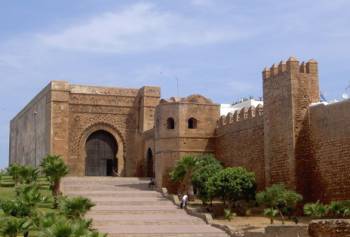 In 1956, after 44 years of occupation, Morocco regained independence from France as the Kingdom of Morocco. Through agreements
with Spain in 1956 and 1958, Moroccan control over certain Spanish-ruled areas was restored, though attempts to claim other Spanish colonial possessions through military action were less successful.
In 1956, after 44 years of occupation, Morocco regained independence from France as the Kingdom of Morocco. Through agreements
with Spain in 1956 and 1958, Moroccan control over certain Spanish-ruled areas was restored, though attempts to claim other Spanish colonial possessions through military action were less successful.
Hassan II became King of Morocco on March 3, 1961. His early years of rule would be marked by political unrest.
The Spanish enclave of Ifni in the south was reintegrated to the country in 1969. Morocco annexed the Western Sahara during the 1970s (Green March) after demanding its reintegration from Spain since independence, but final resolution on the status of the territory remains unresolved.
Present Day:
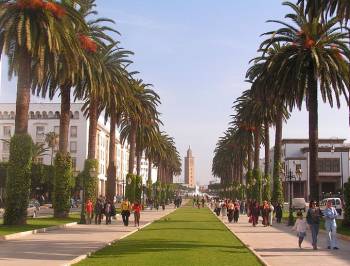 Morocco is a constitutional monarchy with an elected parliament. The King of Morocco holds vast executive powers, including the possibility of dissolving the parliament. Executive power is exercised by the Moroccan government but more importantly by the king himself. The king can also issue decrees called dahirs which have the force of law.
Morocco is a constitutional monarchy with an elected parliament. The King of Morocco holds vast executive powers, including the possibility of dissolving the parliament. Executive power is exercised by the Moroccan government but more importantly by the king himself. The king can also issue decrees called dahirs which have the force of law.
Legislative power is vested in both the government and the two chambers of parliament—the Assembly of Representatives and the Assembly of Councillors.
Morocco was granted Major non-NATO ally status by the United States in June 2004 and has signed free trade agreements with the United States and the European Union.
Parliamentary elections were held in Morocco on September 7, 2007, and were considered by some neutral observers to be mostly free and fair; although voter turnout was estimated to be 37%, the lowest in decades. Morocco has always been known for its islamic liberalism and openness towards the Western world. King Mohammed VI of Morocco with his ruling elite are democratically minded, showing tolerance within the limits of territorial integrity and traditional laws and customs.
Economy:
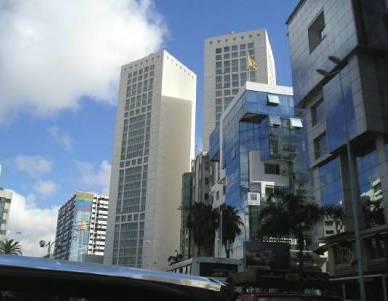 Morocco's economy is considered a relatively liberal economy governed by the law of supply and demand. Since 1993, the country has followed a policy of privatization of certain economic sectors which used to be in the hands of the government. Morocco has become a major player in the African economic affairs, and is the 5th African economy by GDP (PPP). The World Economic Forum placed Morocco as the 2nd most competitive economy in North Africa behind Tunisia, in its African Competitiveness Report 2009. Additionally, Morocco was ranked the 1st African country by the Economist Intelligence Unit' quality-of-life index, ahead of South Africa.
Morocco's economy is considered a relatively liberal economy governed by the law of supply and demand. Since 1993, the country has followed a policy of privatization of certain economic sectors which used to be in the hands of the government. Morocco has become a major player in the African economic affairs, and is the 5th African economy by GDP (PPP). The World Economic Forum placed Morocco as the 2nd most competitive economy in North Africa behind Tunisia, in its African Competitiveness Report 2009. Additionally, Morocco was ranked the 1st African country by the Economist Intelligence Unit' quality-of-life index, ahead of South Africa.
A reliable European ally in fighting terrorism, drug trafficking and illegal immigration, Morocco was granted an “advanced status” from the EU in 2008, shoring up bilateral trade relations with Europe. In 2009 Morocco was ranked among the top thirty countries in the offshoring sector, and has so far attracted roughly half of the French-speaking call centres that have gone offshore so far and a number of the Spanish ones. According to experts, multinational companies are attracted by Morocco's geographical and cultural proximity to Europe.
The major resources of the Moroccan economy are agriculture, phosphates, and tourism. Sales of fish and seafood are important as well. Industry and mining contribute about one-third of the annual GDP. Morocco is the world's third-largest producer of phosphates (after the United States and China). The production of textiles and clothing is part of a growing manufacturing sector that accounted for approximately 34% of total exports in 2002, employing 40% of the industrial workforce.
Demographics:
Morocco has an population of more than 32.2 million as of 2011. Most Moroccans practice Sunni Islam and are of mainly Arab-Berber, Arabized Berber or Berber stock. Morocco has been inhabited by Berbers since at least 5000 years ago. During the Islamic expansion, some Arabs came to Morocco and settled in the flat regions as Tadla and Doukkala. A small minority of the population is identified as Haratin and Gnaoua, dark-skinned sedentary agriculturalists of the southern oases that speak either Berber or Arabic. Morocco's Jewish minority has decreased significantly and today numbers about 5,000.
Most Moroccans speak at least one of the two languages Berber and Moroccan Arabic as a mother tongue. Both languages have regional dialects and accents. Most of the 100,000 foreign residents are French or Spanish.
Ethnic groups include: Arab-Berber 99.1%, other 0.7%, Jewish 0.2%. Religious groups include: Muslim 98.7%, Christian 1.1%, Jewish 0.2%.
According to the European Journal of Human Genetics, Moroccans from North-Western Africa are genetically closer to Iberians and other South Europeans than to Middle Easterners and Sub-Saharan Africans.
Tourism:
Tourism in Morocco is well developed, with a strong tourist industry focused on the country's coast, culture, and history. Morocco has been one of the most politically stable countries in North Africa, which has allowed tourism to develop.
The Moroccan government is heavily investing in tourism development. A large government sponsored marketing campaigns to attract tourists advertised Morocco as a cheap and exotic, yet safe, place for European tourists. Morocco has an excellent road and rail infrastructure that links the major cities and tourist destinations with ports and cities with international airports. Low-cost airlines offer cheap flights to the country.
Morocco's relatively high amount of tourists has been aided by its location, tourist attractions, and relatively low price. Cruise ships visit the ports of Casablanca and Tangier. Morocco is close to Europe and attracts visitors to its beaches. Because of its proximity to Spain, tourists in southern Spain's coastal areas take one- to three-day trips to Morocco.
Tourism is increasingly focused on Morocco's culture, such as its ancient cities. The modern tourist industry capitalizes on Morocco's ancient Roman and Islamic sites, and on its landscape and cultural history. 60% of Morocco's tourists visit for its culture and heritage. The country's attractions can be divided into seven regions: Tangier and the surrounding area; Agadir and its beach resorts; Marrakech; Casablanca; the Imperial cities; Ouarzazate; and Tarfaya and its beach resorts.
Agadir is a major coastal resort and has a third of all Moroccan bed nights. It is a base for tours to the Atlas Mountains. Other resorts in north Morocco are also very popular. Marrakech in central Morocco is a popular tourist destination, but is more popular among tourists for one- and two-day excursions that provide a taste of Morocco's history and culture. As of 2006, activity and adventure tourism in the Atlas and Rif Mountains are the fastest growth area in Moroccan tourism.
Moroccan Cuisine:
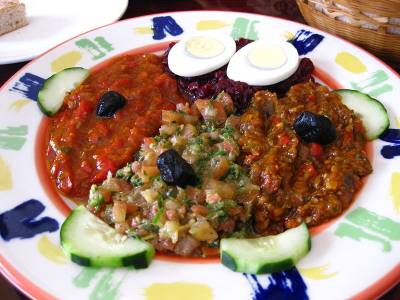 Moroccan cuisine is extremely diverse, thanks to Morocco's interaction with other cultures and nations over the centuries. Moroccan cuisine has been subject to Berber, Moorish, Mediterranean, and Arab influences. The cooks in the royal kitchens of Fez, Meknes, Marrakesh, Rabat and Tetouan refined it over the centuries and created the basis for what is known as Moroccan cuisine today. Moroccan food is known for being far more heavily spiced than Middle Eastern cuisine.
Moroccan cuisine is extremely diverse, thanks to Morocco's interaction with other cultures and nations over the centuries. Moroccan cuisine has been subject to Berber, Moorish, Mediterranean, and Arab influences. The cooks in the royal kitchens of Fez, Meknes, Marrakesh, Rabat and Tetouan refined it over the centuries and created the basis for what is known as Moroccan cuisine today. Moroccan food is known for being far more heavily spiced than Middle Eastern cuisine.
The midday meal is the main meal, except during the holy month of Ramadan. A typical meal begins with a series of hot and cold salads, followed by a tagine. Bread is eaten with every meal. Often, for a formal meal, a lamb or chicken dish is next, followed by couscous topped with meat and vegetables. A cup of sweet mint tea usually ends the meal. Moroccans usually eat with their hands and use bread as a utensil. The consumption of pork and alcohol are considered Haraam, and are prohibited per Muslim dietary restrictions.
Morocco produces a large range of Mediterranean fruits and vegetables and even some tropical ones. Common meats include mutton and lamb, beef, chicken, camel, rabbit and seafood, which serve as a base for the cuisine. Characteristic flavorings include lemon pickle, cold-pressed, unrefined olive oil and dried fruits.
Among the most famous Moroccan dishes are couscous, pastilla (also spelled bestilla), tajine, tanjia and harira.
Spices:
Spices are used extensively in Moroccan food. Although spices have been imported to Morocco for thousands of years, many ingredients, like saffron from Tiliouine, mint and olives from Meknes, and oranges and lemons from Fez, are home-grown. Common spices include karfa (cinnamon), kamoun (cumin), kharkoum (turmeric), skinjbir (ginger), libzar (pepper), tahmira (paprika), anise seed, sesame seeds, qesbour (coriander), andzaafran beldi (saffron). Common herbs include mint and maadnous (parsley.)
Meats:
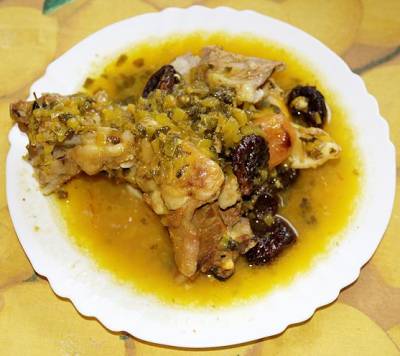 Beef is the most commonly eaten red meat in Morocco. Lamb is preferred, but rarer due to its high rice. North African sheep breeds store most fat in their tails, which means that Moroccan lamb does not have the pungent flavor that Western lamb and mutton have. Poultry is also very common, and the use of seafood is increasing in Moroccan food.
Beef is the most commonly eaten red meat in Morocco. Lamb is preferred, but rarer due to its high rice. North African sheep breeds store most fat in their tails, which means that Moroccan lamb does not have the pungent flavor that Western lamb and mutton have. Poultry is also very common, and the use of seafood is increasing in Moroccan food.
Popular meat dishes include: lamb kebab, ferakh maamer (spring chicken stuffed with sweeten couscous, raisins, and almonds simmered slowly in a sauce made of honey, onion, garlic, ginger, cinnamon, and saffron), koftas (balls of minced or ground beef or lamb mixed with spices and/or onions), merguez (a spicy lamb sausage), mashwi (roasted lamb), mrouzia (a sweet dish of lamb with raisins, almonds and honey).
Salads:
Salads include both raw and cooked ingredients, served either hot or cold. Cold salads include zaalouk (an eggplant and tomato mixture) and taktouka (a mixture of tomatoes, green peppers, garlic and spices).
Desserts:
Usually, seasonal fruits rather than cooked desserts are served at the close of a meal. A common dessert is kaab el ghzal ("gazelle's horns"), a pastry stuffed with almond paste and topped with sugar. Another is halwa shebakia, pretzel-shaped dough deep-fried, dipped into a hot pot of honey and sprinkled with sesame seeds. Coconut fudge cakes, zucre coco, are popular also.
Beverages:
The most popular drink is green tea with mint, more commonly known as "Moroccan mint tea". Traditionally, making good mint tea in Morocco is considered an art form and the drinking of it with friends and family is often a daily tradition. The pouring technique is as crucial as the quality of the tea itself. The Moroccans traditionally like tea with bubbles, so while pouring they hold the teapot high above the glasses. Moroccan tea pots have long, curved pouring spouts and this allows the tea to be poured evenly into tiny glasses from a height. Finally, the tea is accompanied with hard sugar cones or lumps.
Other popular drinks include Moroccan coffee or 'half-half', beet juice and grape juice.
Episodes:
 |
AFRICAN: Wherever you are in Africa, no meal is complete without a starchy porridge known as fufu. |
 |
BRAZILIAN: An exuberant, colorful mix of Portuguese, African and native foods including some from the Amazon. |
 |
CHINESE: Two thirds of households own a wok and use it regularly, but not everyone knows how to use it properly. |
 |
EGYPTIAN: Beans are used extensively and creatively as a source of protein, fibre, and comfort. |
 |
ENGLISH: "Meat & three veg" originated in the UK with dishes like roast beef, steak and kidney pie, and many more. |
 |
FRENCH: The French have elevated food into an art form. Nowhere else is so much attention paid to what people are going to eat and how. |
 |
HUNGARIAN: A fusion of simple peasant food & the elegant, highly developed cuisine from the days of the Austro Hungarian Empire. |
 |
INDIAN: A vibrant, intensely colorful cuisine. Each region of India has its own style of cooking and distinct flavors. |
 |
INDONESIAN: One of the most vibrant and colorful cuisines in the world, full of intense flavor and varied textures. |
 |
ITALIAN: An long-awaited introduction to the kitchens and restaurants of Australia’s top Italian chefs and home cooks. |
 |
JAPANESE: Refined and elegant, its preparation and presentation honed over the centuries so its flavors are pure and delicate. |
 |
JEWISH: While flavors of the Jewish palate are influenced by geography, the constant for Jews all over the world are the Kosher laws. |
 |
KOREAN: Some of the healthiest food on earth, with a near obsession with the fermented vegetable kimchi. |
 |
LEBANESE: Lebanese cuisine is generous and abundant, and this is some of the most exquisite food in the world. |
 |
MALTESE: The rocky island of Malta is home to some beautiful rustic recipes that sing of Mediterranean flavor and freshness. |
 |
MEXICAN: Authentic Mexican food is vibrant, spicy, delicious and fun. It varies according to which region its from. |
 |
PAKISTANI: Full of marvelous and diverse dishes, it incorporates elements from its neighbors India, Afghanistan and Iran. |
 |
PERSIAN: From simple dips to hearty stews, food preparation is taken very seriously in Iran and is often a labor of love. |
 |
SOUTH AMERICAN: A fantastic fusion of culinary traditions from indigenous Indians, imported Africans, and the Spanish and Portuguese colonist. |
 |
SRI LANKAN: This beautiful spice island is a rich melting pot of every nationality that has visited and traded with it over the years. |
 |
SYRIAN: One of the highlights of Syrian food is mezza, a generous spread of small dishes and the prelude to even more food! |
 |
TURKISH: Nestled between Asia and Europe, Turkish food is an unique and exotic fusion with influences from many countries. |
Contact Us | Shop | Sitemap | Join Our Team | Investors | Advertise | Web Design Services
Community | Foodies' Choice | Meetup Groups | Chat | Blogs | Forums | Submit Your Site | Resources




